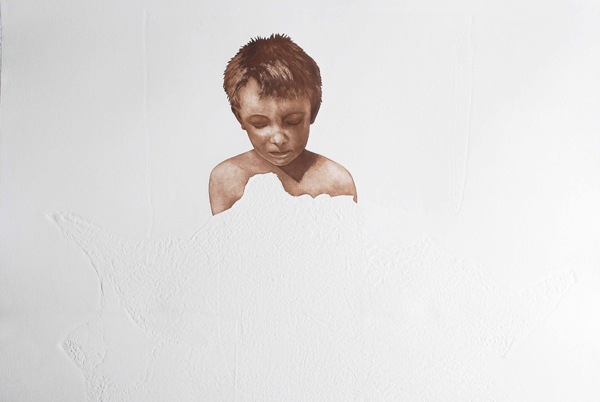
Rhodes Fine Arts lecturer Christine Dixie has had the honour of her exhibition The Binding, purchased, in its entirety, by the Smithsonian Institute of America, which is the world's largest body of galleries and museums.
The exhibition will be displayed in The Smithsonian’s African Art Museum in Washington DC.
The Binding, which is the culmination two and a half years' effort, is an astonishing series of installations. Six etching and collograph prints of impressive scale are accompanied by twin corpse-like silhouettes crafted from hundreds of toy soldiers. The prints, whose emotional power is breathtaking, feature life-size portraits of Dixie's then six-year-old son.
The age of six, says Dixie, is of great significance as that is when a boy begins to migrate from the compassionate maternal realm to the hard, cold and distant realm of the father.
Blind-collographing has been used to ensconce the youth in veil-like blankets, thus positioning the viewer as a father watching his son dream. Viewed in sequence, the series evokes the dispassionate symmetry of beds lined up in an army barrack. In the third panel the boy wakes, totally naked and vulnerable, and gazes at the viewer.
In the fifth panel the boy is once again slumbering, this time completely enveloped by sheepskin. Beneath the surface a toy gun can be perceived in several of the prints.
The works explore the sacrificial nature of the father-son relationship, as embedded in our collective psyche by the biblical narrative of Abraham, who was asked by God to sacrifice his son.
On her choice of medium for these works Dixie says that she was formally trained in the art of print making, and that she "thinks in print". Her use of the technique is masterful and the concept for The Binding was a particularly ambitious one, on both technical and conceptual levels.
Dixie begins with a notion of what she wants to create and lets the idea grow organically throughout the creative process. This non-linear process of concept and creation, allows for an innovative combination of techniques.
Like the large prints, the toy soldier silhouettes, which Dixie calls "embodied shadows", are a note-worthy technical achievement. These sacrificed figures, clearly young boys, lay strewn and dismembered, and the gallery floor itself becomes an alter where blood is spilled in the name of some greater cause.
In creating these intricate constructions Dixie was forced to consider the brutality of war and loss, and she often had to amputate plastic limbs in order to get the soldiers to fit together. As was the artist’s intention, The Binding certainly gets one thinking about the disjuncture between a young boy's fantasy world of soldiers, guns and war, and the intolerable reality of loss and death.
